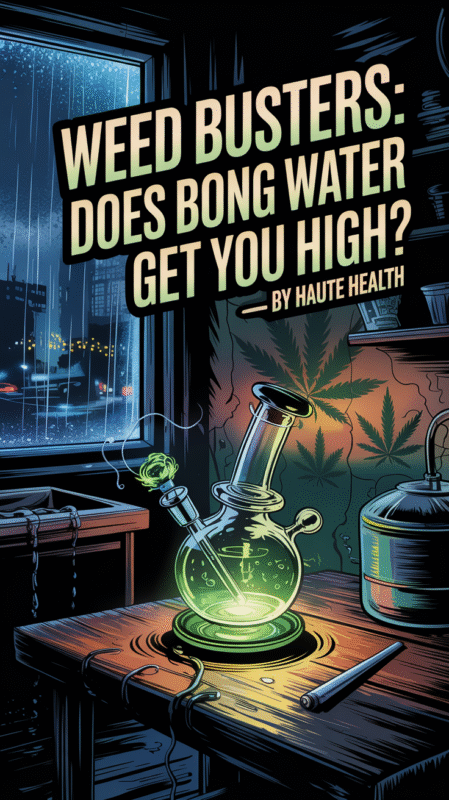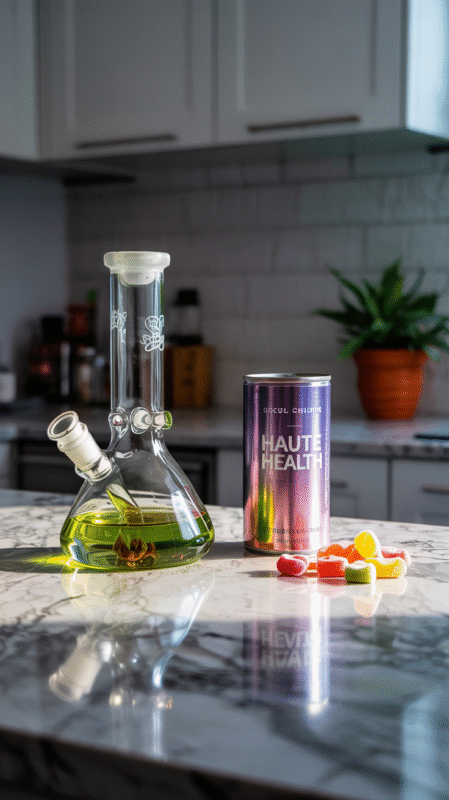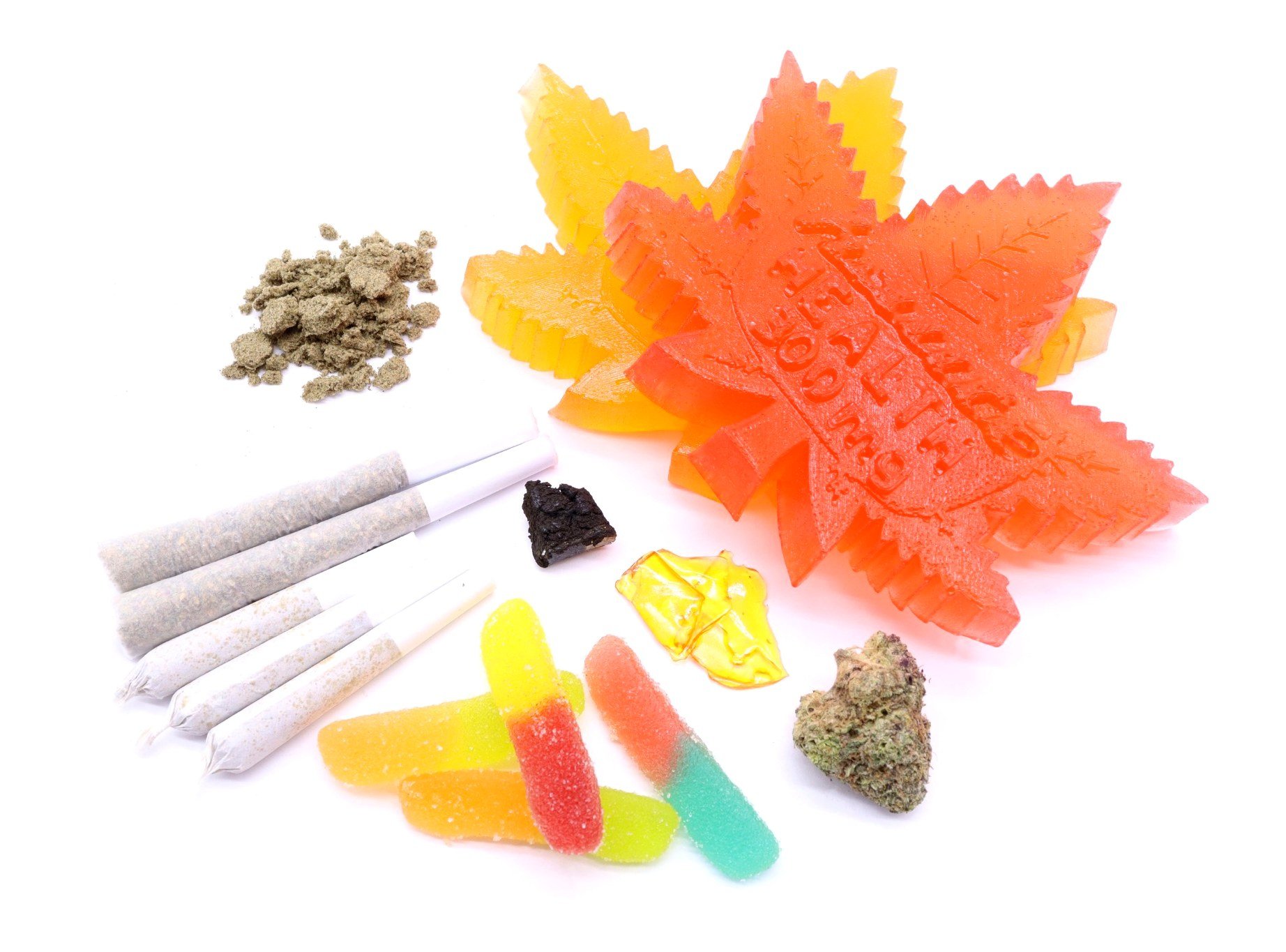
Weed Busters: Does Bong Water Get You High? – by Haute Health
It is midnight in the Okanagan. Rain taps the tin roof, the garage smells like pine cleaner and pepperoni, and the Canucks are losing in overtime again. The bong on the table looks exhausted. Its base holds a tea‑brown mystery that bubbles like a swamp in July. Someone laughs, then the dare lands across the table like a glove drop.
“Drink the bong water. You’ll get ripped.”
Everyone turns. The room quiets. The old space heater clicks. You look at the murk and wonder if this is a secret your high school never taught you. It isn’t.
No, drinking bong water will not get you high in Canada. THC and CBD do not dissolve into plain water, so you are swallowing ash, tar, microbes, and regret. The only buzz is the one from the light fixture.
Table of contents
The dare, the garage, the bet
You have seen this movie before. One friend swears it worked in Grade 10 behind a rink in Saskatoon.
The story is always the same, and the timing is always fuzzy. Four bowls went down first, a brownie disappeared somewhere, and the “bong water high” took the credit. You do not need a lab coat to pick the real culprit, but the myth lives on because the scene is familiar from Halifax to Nanaimo. A late night, a cold garage, and a need for a stunt.
Haute Health exists for the opposite of stunts. We keep things clean, accurate, and shipped across Canada without the mystery. Early in a session or late at night, there is a smarter path than the cup of swamp on the table.
Why THC avoids water
Short answer, chemistry. Long answer, lipids.
THC is lipophilic, so it binds to fats and alcohol rather than water. Experimental references list water solubility for delta‑9‑THC at about 2.8 mg per litre at 23°C, which is tiny compared to what most people feel per dose. In plain language, the good stuff sticks to oil while water shrugs and moves on. If you want effects, you need a fat phase or ethanol in the mix, not tap water in a cold mug. See PubChem and DrugBank for the numbers: PubChem THC record and DrugBank dronabinol profile.
One sip is a short sentence. The science behind it is a longer one that ends with the same verdict.
What is really in bong water
It is not “trapped THC.” It is the leftovers.
You are looking at resin and tar, ash, stale plant specks, and the stuff that grows when water sits. Stagnant water supports biofilm, and biofilm shelters bacteria and fungi while they wait for their next ride. Government guidance in Canada lists biofilm and stagnation as conditions that help Legionella thrive in building systems, which is a good reminder that stale water is a party for microbes, not a pantry for cannabinoids. Read more at the National Research Council and Public Health Ontario: NRC on Legionella risks and PHO Legionella FAQ.
Hookah and bong hardware also turn up in case reports that describe bacteria where you expect them least. One published case linked a home “bong” to Pseudomonas aeruginosa pneumonia, which tells you what loves wet plastic and glass. A garage in Regina is not a hospital, but lungs do not care about postal codes. See the case summary on PubMed: Marijuana “bong” Pseudomonas lung infection.
Two facts in a row say the same thing. That water carries ash and microbes, not a magic stash of THC.

Cannabis tea done right
You heard tea works. It does, if you respect two steps.
First, decarboxylation. Raw flower holds THCA, which needs heat to flip into THC. Peer‑reviewed work reports strong conversion for THCA when heated around 110°C for 30 to 40 minutes, with faster conversion at higher temps and more risk of degradation when you push it. Read the study: Decarboxylation of acidic cannabinoids and the journal PDF summary from the same team: 110°C, 130°C, 145°C decarb times.
Second, fat. Use whole milk, cream, coconut oil, or butter so the cannabinoids have a place to land. A proper cannabis tea reads like a latte recipe, not a “steep bag, wait five minutes” routine. Add a little honey, cue a snowy night in Fredericton, and suddenly the living room feels friendly.
One short rule and one longer recipe change the outcome.
How drinks work in Canada
Beverages on shelves look watery. Inside, they are not.
Producers use nano‑emulsification to keep cannabinoids suspended in water. That is how a drink can hit in 10 to 20 minutes while plain water does nothing. The Ontario Cannabis Store has a simple explainer and notes that some drinks use nanoemulsions for faster onset: OCS on ingestion and nanoemulsion. Federal rules also limit edible cannabis to 10 mg THC per package, which is why a single can stops at that number while extracts go far higher per bottle with dosing mechanisms. See Health Canada: Classification of edible cannabis and the Cannabis Regulations text: Maximum 10 mg THC per immediate container.
A short tech term carries a long story of food science, measurement, and testing.
Smart ways to feel effects
Skip the dare. Pick the route with control.
-
Edibles – pre‑dosed and tidy. Start at 2.5 mg or 5 mg and step up based on feel. Try our fresh picks in the edibles shop.
-
Drinks – quick onset with nano‑emulsion. Movie nights in Winnipeg feel warmer with a cold can from the cannabis drinks section.
-
Tinctures – under‑the‑tongue, measured droppers. Find options in oils and tinctures.
-
Home infusion – decarb low and slow, then blend with butter or coconut oil for tea or baking.
At the start of your night or near the end, the clean path is the same. A quiet routine beats a loud dare.
The myth’s Canadian roots
It spread the same way urban legends spread. One friend claimed victory in Moose Jaw, another heard a cousin pulled it off in Thunder Bay, and a Reddit thread from 2009 kept the story alive.
Part of the confusion comes from the way water pipes look. Smoke passes through water, so people assume the water collects the strong part. In truth, the water collects smell and soot while the active compounds behave like grease on a cold pan. The idea feels clever because the glass gurgles like science equipment, and the scene looks like a lab, but the chemistry never backed the claim. Next thing you know, someone in Prince George is reenacting the myth while everyone else reaches for the paper towels.
Two provinces, one pattern. The stunt is memorable, the facts are simple.
Quick facts
-
THC is fat‑soluble, not water‑soluble. Measured water solubility sits near 2.8 mg/L at 23°C.
-
Stagnant water grows biofilm that shelters microbes. See the Canadian guidance above for why that matters.
-
Decarb matters. Heat around 110°C for 30–40 minutes converts THCA to THC before you infuse.
-
Drinks hit faster when they use nano‑emulsions. Expect 10–20 minutes for onset in many products.
-
Edibles in Canada are capped at 10 mg THC per package by federal rules.
Short points help you remember, longer nights help you test them.
FAQ
Does drinking bong water get you high in Canada
No. THC does not dissolve into water, so the base stays weak while ash and microbes move in.
Is plain “weed tea” worth trying
Not for effects. Without decarb and fat, you get flavour and colour rather than a meaningful dose.
What if the bong water looks clean
Fresh water still catches soot and saliva during a session, and standing water welcomes biofilm. Empty, rinse, and refill each time.
How do nano drinks feel different from edibles
Many hit faster, often in 10–20 minutes, while classic edibles build over 30–120 minutes. Always read the label and start low.
What should I do if I already swallowed some
Hydrate, brush your teeth, and move on. If you feel unwell, talk to a professional.
Short answers work fast. Longer guidance sits in the sections above if you need it.


